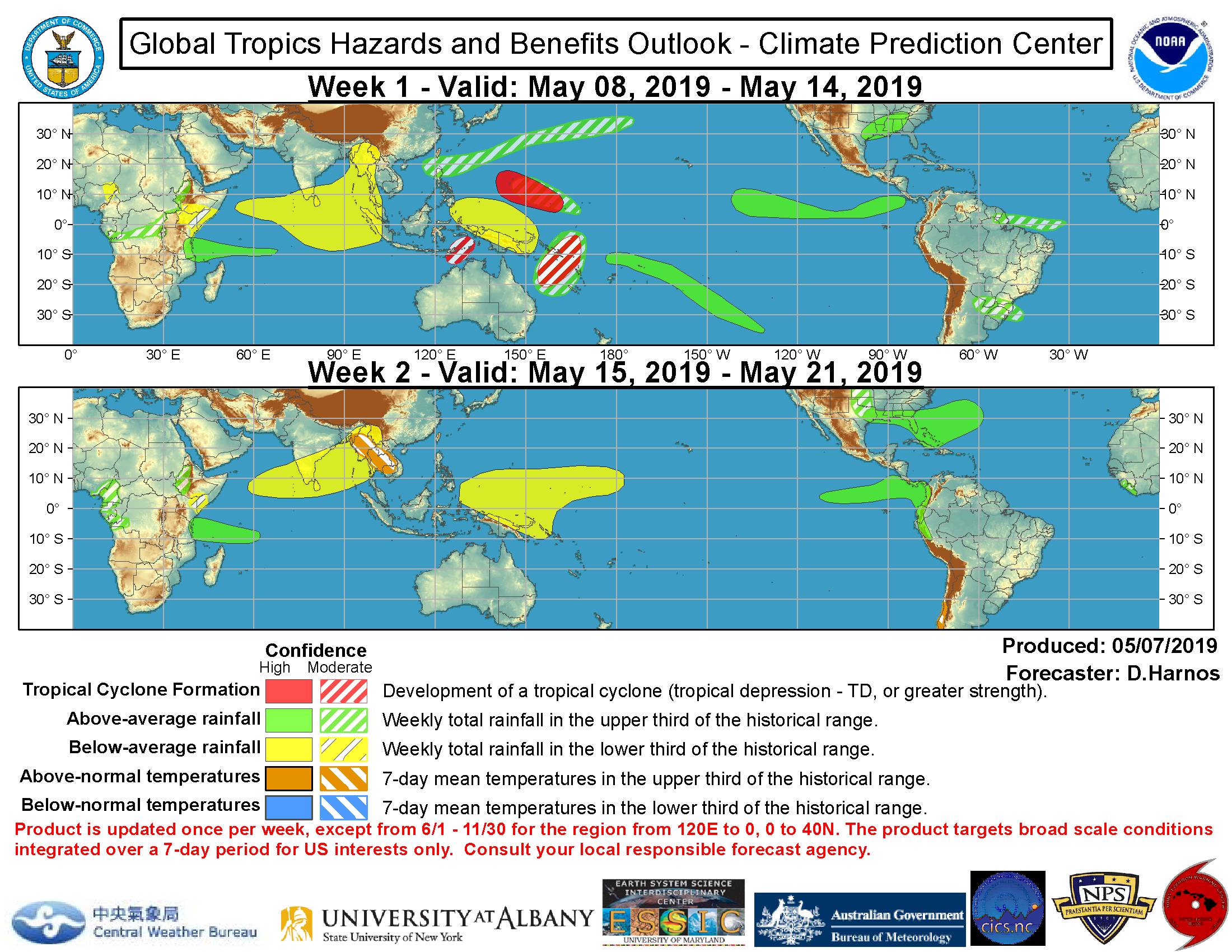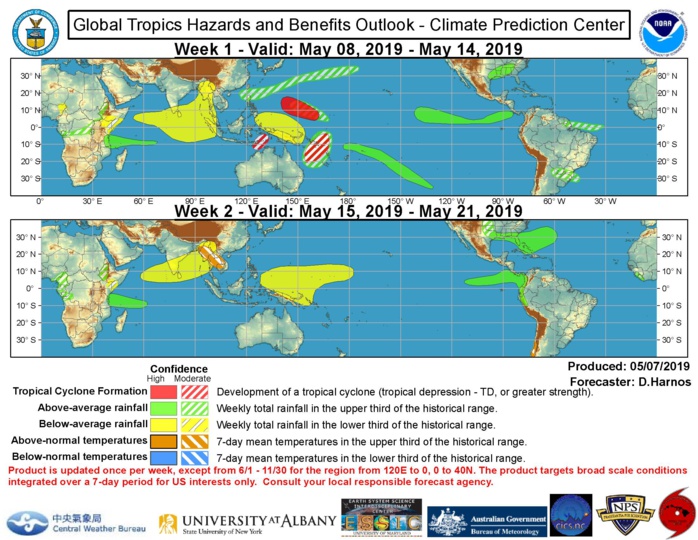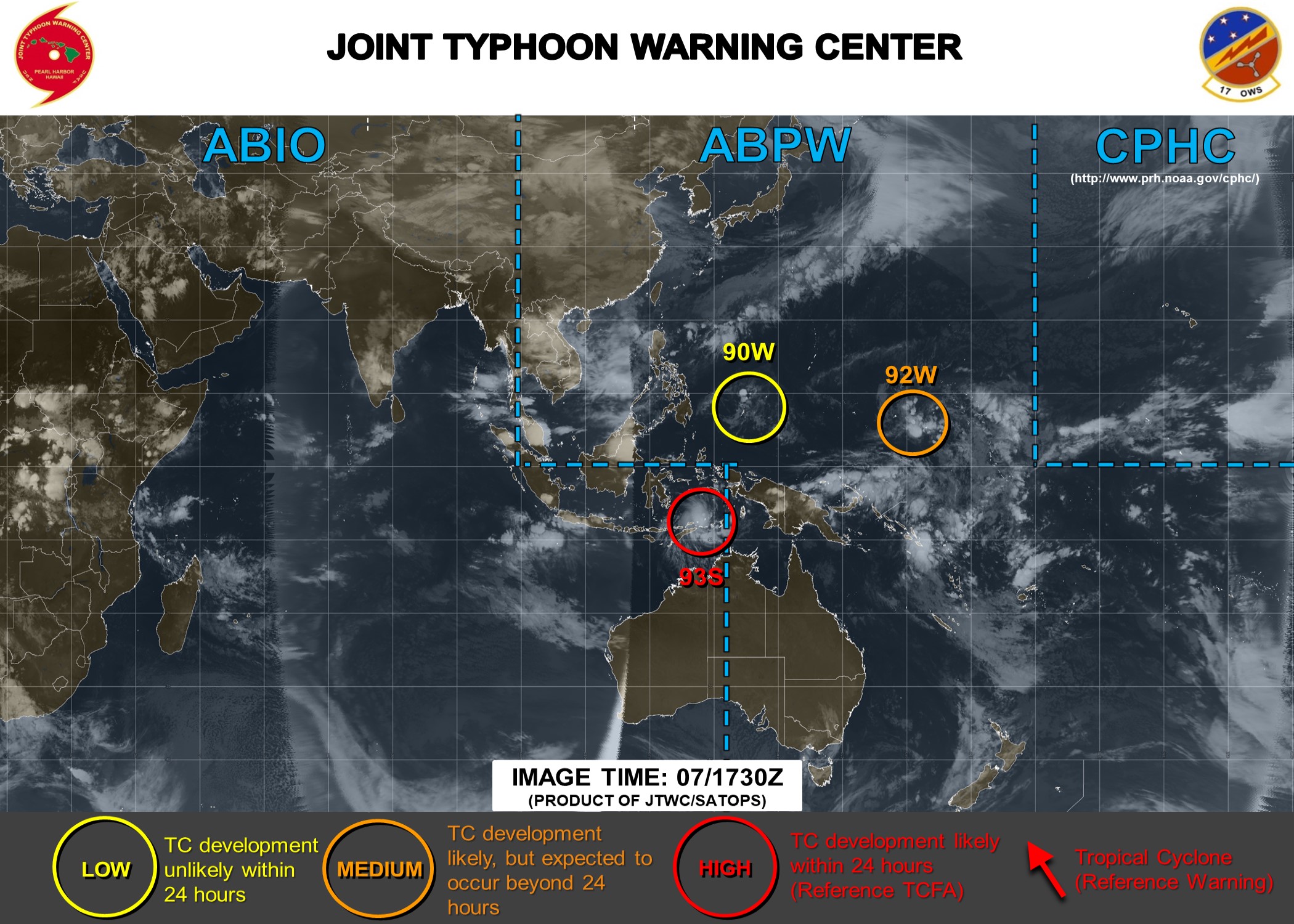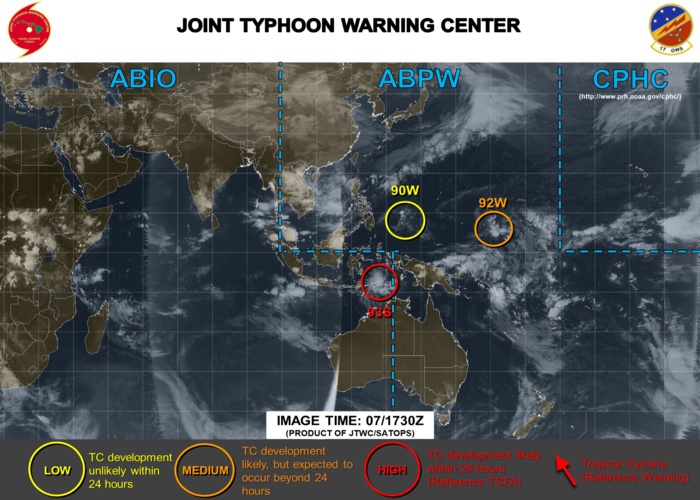https://www.meteo974.re/M974World_r7.html
https://www.meteo974.re/
Global Tropics Hazards and Benefits Outlook Discussion
Last Updated: 05.07.19 Valid: 05.08.19 - 05.21.19
Over the past week the Madden-Julian Oscillation (MJO) rapidly crossed the Maritime Continent and is currently over the West Pacific. Model guidance is consistent in bringing the MJO eastward over the coming days, although with a brief slowdown early tied to possible tropical cyclone (TC) formation over the West Pacific. The MJO is forecast to be over the West Pacific during Week-1 (Phases 6/7), and over the Western Hemisphere during Week-2 (Phases 8/1). The ECMWF model is a bit faster with the MJO progression relative to the GEFS, and also shows some weakening of the intraseasonal signal late in Week-2 that is absent in the GEFS. Also of interest is a Kelvin wave emerging from the enhanced MJO envelope and presently near the Date Line. This atmospheric Kelvin wave and the MJO have both helped to trigger a westerly wind burst along the equator, which has likely implications for driving a downwelling oceanic Kelvin wave that helps reinforce subsurface warm water volume in the Pacific and prolong the current El Nino event.
No TCs formed globally over the past seven days. The most noteworthy occurrence was TC Fani impacting portions of India and Bangladesh. Fani made landfall on the third of May with 150 mph winds over eastern India, and continued tracking into East Asia. Across India and Bangladesh, tens of millions were impacted by the storm, with severe damage to infrastructure on top of dozens of fatalities. At present the Joint Typhoon Warning Center (JTWC) is monitoring three separate areas for possible development in the near future. The first is a system presently near 5N/162E that is forecast to track slowly west-northwestward over the coming week. JTWC gives this a medium chance of becoming a TC prior to the forecast period, with high confidence given in this outlook since the period extends for a full week. This system is likely to track toward Guam by early next week, with interested parties referred to the Guam Forecast Office or JTWC for further information. JTWC is also monitoring a low in the Timor Sea, currently near 6S/128E. JTWC gives a low chance of the system becoming a TC within 24 hours, but overall favorable conditions exist for several days, leading to moderate confidence of formation while the system slowly drifts southward in the coming week. In addition, JTWC is tracking a low near 8N/136E that is forecast to track westward. Model guidance is not bullish on this system developing, while JTWC gives it a low chance of formation in the next 24 hours, so the system is left entirely off the forecast graphic. Also while not currently currently being tracked by JTWC a system may develop near Vanuatu at some point between the start of the forecast period and end of this week. This system is given a moderate chance of TC formation, and is forecast to track south-southwestward into the Coral Sea over the coming week. No TC formation is currently anticipated during Week-2, but with the East Pacific hurricane season beginning on May 15th and the MJO forecast to reach the Western Hemisphere during Week-2, there is some potential for development in the basin, although confidence is insufficient for formation at this time.
During Week-1 confidence is high for above-median and below-median precipitation tied to the active (inactive) portion of the MJO envelope across the Pacific (Indian Ocean and Maritime Continent). The active MJO over the West Pacific also is linked to an enhanced South Pacific Convergence Zone, where high confidence for above-normal precipitation exists during Week-1. Anomalously warm sea surface temperatures persist in a band near 10S in the southern Indian Ocean, leading to high confidence for above-median rainfall to persist from eastern Tanzania through approximately 60E during each of the next two weeks. Enhanced flow of moisture out of the Gulf of Mexico also leads to high confidence for above-median rainfall across much of the Gulf Coast region through Tennessee Valley during Week-1. Areas of lesser confidence in Week-1 for above-median rainfall include frontal activity in the West Pacific, a Rossby wave tracking across the equatorial Atlantic, a slight MJO footprint across southern Brazil, and the possible TC tracks in the West and South Pacific.
The Week-2 outlook exhibits high confidence for below-median precipitation continuing across parts of the Indian Ocean, Southeast Asia, and West Pacific tied to the suppressed phase of the MJO. Model guidance also indicates a relatively hot period during Week-2 across portions of Southeast Asia also linked to the MJO suppressing convection across the region. The MJO is likely to be active over the Western Hemisphere during this period as well, leading to high confidence for above-median precipitation for parts of the East Pacific through coastal portions of South America. A wet pattern also looks likely to continue near the Gulf of Mexico, with high confidence for above-median precipitation linked to a stalled frontal boundary stretching into the Western Atlantic. There is also moderate confidence for some moisture beginning to make it northward into the Great Plains later in Week-2. The only other area of focus during Week-2 is the potential for above-normal temperatures across parts of Chile per model guidance.
Forecasts over Africa are made in consultation with the CPC International Desk, and can represent local-scale conditions in addition to global-scale variability.
Product Release Information
The full Global Tropics Hazards and Benefits Outlook (GTH) is released once per week every Tuesday at 1730 UTC (1830 UTC when on standard time) including U.S. federal holidays. At the time of product release, there is a live briefing (available via webinar) open to all interested parties in which the latest conditions in the Tropics and the just released outlook and associated impacts are discussed. There is an opportunity to ask questions after the briefing and the briefings are available at the Live Briefing Archive and soon will be recorded.
CPC also issues an operational update of this product every Friday by 1730 UTC to further support the NWS regions. The update only spans the release period from June 1 through November 30 and a region from 120E to the Prime Meridian in longitude and from the equator to 40N in latitude. The update does not extend the time horizon of the product, but rather applies for the remaining 4 days of the previous Week-1 time period and Days 5-11 from the previous Week-2 period. This page will depict both the original and updated outlook maps as well short text outlining the forecast rationale for any changes.
Product Description
The Global Tropics Hazards and Benefits Outlook is a forecast for areas with elevated odds for above- or below-median rainfall, above- or below-normal temperatures and regions where tropical cyclogenesis is favored for the upcoming Week-1 and Week-2 time periods. The rainfall outlook is for precipitation integrated over a week and targets broad-scale patterns, not local conditions as they will be highly variable. Above(below) median rainfall forecast areas are depicted in green and yellow respectively. Above(below) normal temperature forecast areas are depicted in orange and below respectively. Favored areas for tropical development are shown in red. Two measures of confidence are indicated, high (solid) and moderate (hatched) and are currently subjective in nature and not based on an objective system. Work towards a probabilistic format of the product and so an objective measure of confidence is ongoing. The weekly verification period ranges from 00 UTC Wednesday to 00 UTC the following Wednesday.
Along with the product graphic, a written text outlook discussion is also included at release time. The narrative provides a review of the past week across the global Tropics, a description of the current climate-weather situation, the factors and reasoning behind the depicted outlook and notes on any other issues the user should be aware of. The discussion discusses the impacts in the Tropics as well as potential impacts in the Extratropics when relevant.
Product Physical Basis
The product synthesizes information and expert analysis related to climate variability across multiple time scales and from various sources, including operational climate monitoring products. The physical basis for the outlooks include El Nino-Southern Oscillation (ENSO) , the Madden-Julian Oscillation (MJO), strength and variations of the monsoon systems, other coherent subseasonal tropical variability such as atmospheric Kelvin waves (KW), Equatorial Rossby waves (ERW), African easterly waves, as well as interactions with the extratropical circulation (i.e. high latitude blocking, low-latitude frontal activity, etc.).
Product Forecast Tools
The outlook maps are currently created subjectively based on a number of forecast tools, many of which are objective. The final depiction is an assessment of these forecast tools based on a number of factors to create the final product. Work is ongoing to create an objective consolidation of some of the available forecast tools to serve as a first guess for the forecaster. Forecast tools include MJO composites, empirical and dynamical based MJO, ERW and KW forecasts, and raw dynamical model guidance from a number of modeling systems. Tropical cyclone areas are based on MJO composites and statistical and dynamical tropical cyclone forecasts as well as raw model forecast guidance.
Product Purpose
The product supports the NOAA mission in three primary ways:
Assess and forecast important changes in the distribution of tropical convection (i.e., potential circulation changes across the Pacific and North America sectors) and communicate this information to NWS forecasters
Provide advance notice of potential hazards related to climate, weather and hydrological events across the global tropics (including tropical cyclone risks for several NWS regions)
Support various sectors of the U.S. economy (finance, energy, agriculture, water resource management) that have foreign interests.
Product Partners
The product is created through collaboration with other NOAA centers, [the National Hurricane Center (NHC) and the Central Pacific Hurricane Center (CPHC)], the Department of Defense [The Joint Typhoon Warning Center (JTWC) and the Naval Postgraduate School (NPS)], the Australian Bureau of Meteorology, Taiwan Central Weather Bureau, the State University of New York at Albany (SUNY) and the Center for Climate and Satellites (CICS), among other collaborators.
Product Users and Applications
Known users include U.S. government agencies such as NOAA [National Weather Service (NWS), River Forecast Centers (RFCs), the National Marine Fisheries Service (NMFS), the Department of the Interior (U.S. Forest Service), aid organizations (U.S. and international Red Cross, USAID), domestic and global private sector interests (financial, energy, water resource management and agricultural sectors), international weather services and various media meteorologists.
Some special applications of the product in the past include extended range predictions to support Haiti earthquake and Deepwater Horizon oil spill relief efforts as well as support for the Dynamics of the MJO (DYNAMO) scientific field campaign held from October 2011 through March 2012.
Product Archive
Product Resources
ENSO weekly update:
http://www.cpc.ncep.noaa.gov/products/analysis_monitoring/lanina/enso_evolution-status-fcsts-web.pdf
MJO weekly update:
http://www.cpc.ncep.noaa.gov/products/precip/CWlink/MJO/mjoupdate.pdf
Earth System Research Laboratory
http://www.cdc.noaa.gov
National Hurricane Center:
http://www.nhc.noaa.gov/
Central Pacific Hurricane Center:
http://www.prh.noaa.gov/hnl/cphc/
Joint Typhoon Warning Center:
http://www.usno.navy.mil/JTWC
CPC African Desk:
http://www.cpc.ncep.noaa.gov/products/african_desk/
USAID/FEWS:
http://www.cpc.ncep.noaa.gov/products/fews/
Australian Government Bureau of Meteorology:
http://www.bom.gov.au/climate/
http://www.bom.gov.au/weather/nt/
https://www.meteo974.re/
Global Tropics Hazards and Benefits Outlook Discussion
Last Updated: 05.07.19 Valid: 05.08.19 - 05.21.19
Over the past week the Madden-Julian Oscillation (MJO) rapidly crossed the Maritime Continent and is currently over the West Pacific. Model guidance is consistent in bringing the MJO eastward over the coming days, although with a brief slowdown early tied to possible tropical cyclone (TC) formation over the West Pacific. The MJO is forecast to be over the West Pacific during Week-1 (Phases 6/7), and over the Western Hemisphere during Week-2 (Phases 8/1). The ECMWF model is a bit faster with the MJO progression relative to the GEFS, and also shows some weakening of the intraseasonal signal late in Week-2 that is absent in the GEFS. Also of interest is a Kelvin wave emerging from the enhanced MJO envelope and presently near the Date Line. This atmospheric Kelvin wave and the MJO have both helped to trigger a westerly wind burst along the equator, which has likely implications for driving a downwelling oceanic Kelvin wave that helps reinforce subsurface warm water volume in the Pacific and prolong the current El Nino event.
No TCs formed globally over the past seven days. The most noteworthy occurrence was TC Fani impacting portions of India and Bangladesh. Fani made landfall on the third of May with 150 mph winds over eastern India, and continued tracking into East Asia. Across India and Bangladesh, tens of millions were impacted by the storm, with severe damage to infrastructure on top of dozens of fatalities. At present the Joint Typhoon Warning Center (JTWC) is monitoring three separate areas for possible development in the near future. The first is a system presently near 5N/162E that is forecast to track slowly west-northwestward over the coming week. JTWC gives this a medium chance of becoming a TC prior to the forecast period, with high confidence given in this outlook since the period extends for a full week. This system is likely to track toward Guam by early next week, with interested parties referred to the Guam Forecast Office or JTWC for further information. JTWC is also monitoring a low in the Timor Sea, currently near 6S/128E. JTWC gives a low chance of the system becoming a TC within 24 hours, but overall favorable conditions exist for several days, leading to moderate confidence of formation while the system slowly drifts southward in the coming week. In addition, JTWC is tracking a low near 8N/136E that is forecast to track westward. Model guidance is not bullish on this system developing, while JTWC gives it a low chance of formation in the next 24 hours, so the system is left entirely off the forecast graphic. Also while not currently currently being tracked by JTWC a system may develop near Vanuatu at some point between the start of the forecast period and end of this week. This system is given a moderate chance of TC formation, and is forecast to track south-southwestward into the Coral Sea over the coming week. No TC formation is currently anticipated during Week-2, but with the East Pacific hurricane season beginning on May 15th and the MJO forecast to reach the Western Hemisphere during Week-2, there is some potential for development in the basin, although confidence is insufficient for formation at this time.
During Week-1 confidence is high for above-median and below-median precipitation tied to the active (inactive) portion of the MJO envelope across the Pacific (Indian Ocean and Maritime Continent). The active MJO over the West Pacific also is linked to an enhanced South Pacific Convergence Zone, where high confidence for above-normal precipitation exists during Week-1. Anomalously warm sea surface temperatures persist in a band near 10S in the southern Indian Ocean, leading to high confidence for above-median rainfall to persist from eastern Tanzania through approximately 60E during each of the next two weeks. Enhanced flow of moisture out of the Gulf of Mexico also leads to high confidence for above-median rainfall across much of the Gulf Coast region through Tennessee Valley during Week-1. Areas of lesser confidence in Week-1 for above-median rainfall include frontal activity in the West Pacific, a Rossby wave tracking across the equatorial Atlantic, a slight MJO footprint across southern Brazil, and the possible TC tracks in the West and South Pacific.
The Week-2 outlook exhibits high confidence for below-median precipitation continuing across parts of the Indian Ocean, Southeast Asia, and West Pacific tied to the suppressed phase of the MJO. Model guidance also indicates a relatively hot period during Week-2 across portions of Southeast Asia also linked to the MJO suppressing convection across the region. The MJO is likely to be active over the Western Hemisphere during this period as well, leading to high confidence for above-median precipitation for parts of the East Pacific through coastal portions of South America. A wet pattern also looks likely to continue near the Gulf of Mexico, with high confidence for above-median precipitation linked to a stalled frontal boundary stretching into the Western Atlantic. There is also moderate confidence for some moisture beginning to make it northward into the Great Plains later in Week-2. The only other area of focus during Week-2 is the potential for above-normal temperatures across parts of Chile per model guidance.
Forecasts over Africa are made in consultation with the CPC International Desk, and can represent local-scale conditions in addition to global-scale variability.
Product Release Information
The full Global Tropics Hazards and Benefits Outlook (GTH) is released once per week every Tuesday at 1730 UTC (1830 UTC when on standard time) including U.S. federal holidays. At the time of product release, there is a live briefing (available via webinar) open to all interested parties in which the latest conditions in the Tropics and the just released outlook and associated impacts are discussed. There is an opportunity to ask questions after the briefing and the briefings are available at the Live Briefing Archive and soon will be recorded.
CPC also issues an operational update of this product every Friday by 1730 UTC to further support the NWS regions. The update only spans the release period from June 1 through November 30 and a region from 120E to the Prime Meridian in longitude and from the equator to 40N in latitude. The update does not extend the time horizon of the product, but rather applies for the remaining 4 days of the previous Week-1 time period and Days 5-11 from the previous Week-2 period. This page will depict both the original and updated outlook maps as well short text outlining the forecast rationale for any changes.
Product Description
The Global Tropics Hazards and Benefits Outlook is a forecast for areas with elevated odds for above- or below-median rainfall, above- or below-normal temperatures and regions where tropical cyclogenesis is favored for the upcoming Week-1 and Week-2 time periods. The rainfall outlook is for precipitation integrated over a week and targets broad-scale patterns, not local conditions as they will be highly variable. Above(below) median rainfall forecast areas are depicted in green and yellow respectively. Above(below) normal temperature forecast areas are depicted in orange and below respectively. Favored areas for tropical development are shown in red. Two measures of confidence are indicated, high (solid) and moderate (hatched) and are currently subjective in nature and not based on an objective system. Work towards a probabilistic format of the product and so an objective measure of confidence is ongoing. The weekly verification period ranges from 00 UTC Wednesday to 00 UTC the following Wednesday.
Along with the product graphic, a written text outlook discussion is also included at release time. The narrative provides a review of the past week across the global Tropics, a description of the current climate-weather situation, the factors and reasoning behind the depicted outlook and notes on any other issues the user should be aware of. The discussion discusses the impacts in the Tropics as well as potential impacts in the Extratropics when relevant.
Product Physical Basis
The product synthesizes information and expert analysis related to climate variability across multiple time scales and from various sources, including operational climate monitoring products. The physical basis for the outlooks include El Nino-Southern Oscillation (ENSO) , the Madden-Julian Oscillation (MJO), strength and variations of the monsoon systems, other coherent subseasonal tropical variability such as atmospheric Kelvin waves (KW), Equatorial Rossby waves (ERW), African easterly waves, as well as interactions with the extratropical circulation (i.e. high latitude blocking, low-latitude frontal activity, etc.).
Product Forecast Tools
The outlook maps are currently created subjectively based on a number of forecast tools, many of which are objective. The final depiction is an assessment of these forecast tools based on a number of factors to create the final product. Work is ongoing to create an objective consolidation of some of the available forecast tools to serve as a first guess for the forecaster. Forecast tools include MJO composites, empirical and dynamical based MJO, ERW and KW forecasts, and raw dynamical model guidance from a number of modeling systems. Tropical cyclone areas are based on MJO composites and statistical and dynamical tropical cyclone forecasts as well as raw model forecast guidance.
Product Purpose
The product supports the NOAA mission in three primary ways:
Assess and forecast important changes in the distribution of tropical convection (i.e., potential circulation changes across the Pacific and North America sectors) and communicate this information to NWS forecasters
Provide advance notice of potential hazards related to climate, weather and hydrological events across the global tropics (including tropical cyclone risks for several NWS regions)
Support various sectors of the U.S. economy (finance, energy, agriculture, water resource management) that have foreign interests.
Product Partners
The product is created through collaboration with other NOAA centers, [the National Hurricane Center (NHC) and the Central Pacific Hurricane Center (CPHC)], the Department of Defense [The Joint Typhoon Warning Center (JTWC) and the Naval Postgraduate School (NPS)], the Australian Bureau of Meteorology, Taiwan Central Weather Bureau, the State University of New York at Albany (SUNY) and the Center for Climate and Satellites (CICS), among other collaborators.
Product Users and Applications
Known users include U.S. government agencies such as NOAA [National Weather Service (NWS), River Forecast Centers (RFCs), the National Marine Fisheries Service (NMFS), the Department of the Interior (U.S. Forest Service), aid organizations (U.S. and international Red Cross, USAID), domestic and global private sector interests (financial, energy, water resource management and agricultural sectors), international weather services and various media meteorologists.
Some special applications of the product in the past include extended range predictions to support Haiti earthquake and Deepwater Horizon oil spill relief efforts as well as support for the Dynamics of the MJO (DYNAMO) scientific field campaign held from October 2011 through March 2012.
Product Archive
Product Resources
ENSO weekly update:
http://www.cpc.ncep.noaa.gov/products/analysis_monitoring/lanina/enso_evolution-status-fcsts-web.pdf
MJO weekly update:
http://www.cpc.ncep.noaa.gov/products/precip/CWlink/MJO/mjoupdate.pdf
Earth System Research Laboratory
http://www.cdc.noaa.gov
National Hurricane Center:
http://www.nhc.noaa.gov/
Central Pacific Hurricane Center:
http://www.prh.noaa.gov/hnl/cphc/
Joint Typhoon Warning Center:
http://www.usno.navy.mil/JTWC
CPC African Desk:
http://www.cpc.ncep.noaa.gov/products/african_desk/
USAID/FEWS:
http://www.cpc.ncep.noaa.gov/products/fews/
Australian Government Bureau of Meteorology:
http://www.bom.gov.au/climate/
http://www.bom.gov.au/weather/nt/








